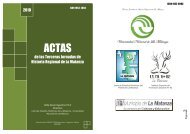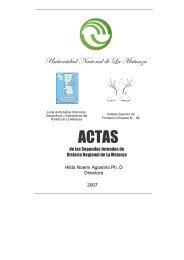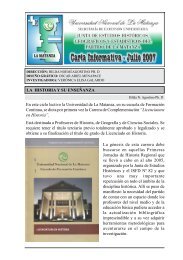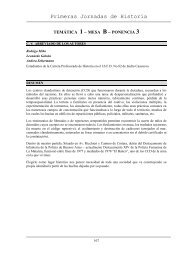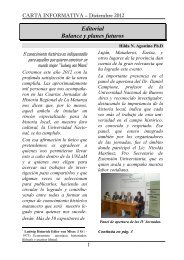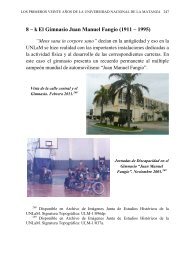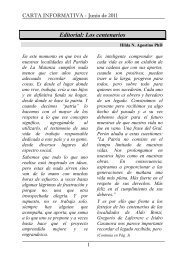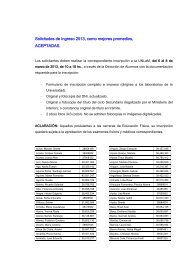Parte 3 - Universidad Nacional de La Matanza
Parte 3 - Universidad Nacional de La Matanza
Parte 3 - Universidad Nacional de La Matanza
Create successful ePaper yourself
Turn your PDF publications into a flip-book with our unique Google optimized e-Paper software.
Temática 2<br />
Mesa C - Ponencia 2<br />
Aspectos interculturales en el aula <strong>de</strong> Inglés nivel 1<br />
<strong>de</strong> la <strong>Universidad</strong> <strong>Nacional</strong> <strong>de</strong> <strong>La</strong> <strong>Matanza</strong><br />
CHRISTMAS DAY<br />
The birth of Christ is remembered on 25 th December Grandparents, aunts, uncles and<br />
cousins all meet for a big Christmas dinner of roast turkey and vegetables and then<br />
Christmas pudding. People put <strong>de</strong>corations on Christmas trees and give presents and<br />
cards. Children traditionally put up stockings on Christmas Eve for Father Christmas to<br />
till with presents<br />
1) Work in groups of three (stu<strong>de</strong>nts A, B and C). Each stu<strong>de</strong>nt, read about a different<br />
celebration in Britain and complete that part of fue chart.<br />
Date of celebration<br />
Reason for celebration<br />
Special food<br />
Special activities<br />
Halloween Chrlstmas Day Guy Fawkes Nlght<br />
2) Work with the other stu<strong>de</strong>nts in the group. Tell the two other stu<strong>de</strong>nts about the text<br />
you read. Listen to the other stu<strong>de</strong>nts and complete the chart.<br />
3) Talk about the traditions in your country or family. You can speak about:<br />
-marriages, religious festivals, funerals and birthdays<br />
-special food, clothes or presents.<br />
-what you say on each occasion<br />
4) In which of fue celebrations <strong>de</strong>scribed by your partners or in fue leaflet above would<br />
you like to participate? Why?<br />
<strong>La</strong>s activida<strong>de</strong>s se realizaron en grupos <strong>de</strong> tres estudiantes, cada uno <strong>de</strong> los cuales <strong>de</strong>bía<br />
leer acerca <strong>de</strong> una <strong>de</strong> las celebraciones y luego completar la parte pertinente <strong>de</strong>l cuadro.<br />
(Actividad 1) como parte <strong>de</strong> una actividad <strong>de</strong> comprensión lectora y <strong>de</strong> manejo <strong>de</strong><br />
vocabulario específico. Luego se proponía una puesta en común sobre las tres<br />
celebraciones (Actividad 2). Fue muy interesante <strong>de</strong>scubrir que si bien los alumnos<br />
conocían en <strong>de</strong>talle la celebración <strong>de</strong> Halloween gracias al cine y la televisión, no tenían<br />
casi información previa sobre <strong>La</strong> noche <strong>de</strong> Guy Fawkes, festividad británica que se<br />
remonta al siglo XVII. A<strong>de</strong>más fue muy interesante y enriquecedor el diálogo sobre el<br />
contraste en las formas <strong>de</strong> celebrar la Navidad en países <strong>de</strong> habla inglesa y en el nuestro.<br />
En la Actividad 3 la consigna era un intercambio oral y luego escrito sobre las tradiciones<br />
regionales o familiares <strong>de</strong> los alumnos como casamientos, festivida<strong>de</strong>s religiosas,<br />
funerales o cumpleaños. Allí se invitaba a <strong>de</strong>scribir en <strong>de</strong>talle qué comidas, vestimentas,<br />
regalos o ritos se cumplen y qué se estila <strong>de</strong>cir en cada ocasión.<br />
A modo <strong>de</strong> ejemplo se presenta este cuadro con un grupo <strong>de</strong> 32 grupos <strong>de</strong> 1 a 3<br />
estudiantes <strong>de</strong> distintas comisiones (Algunos estudiantes <strong>de</strong>scribieron más <strong>de</strong> una<br />
celebración):<br />
251




